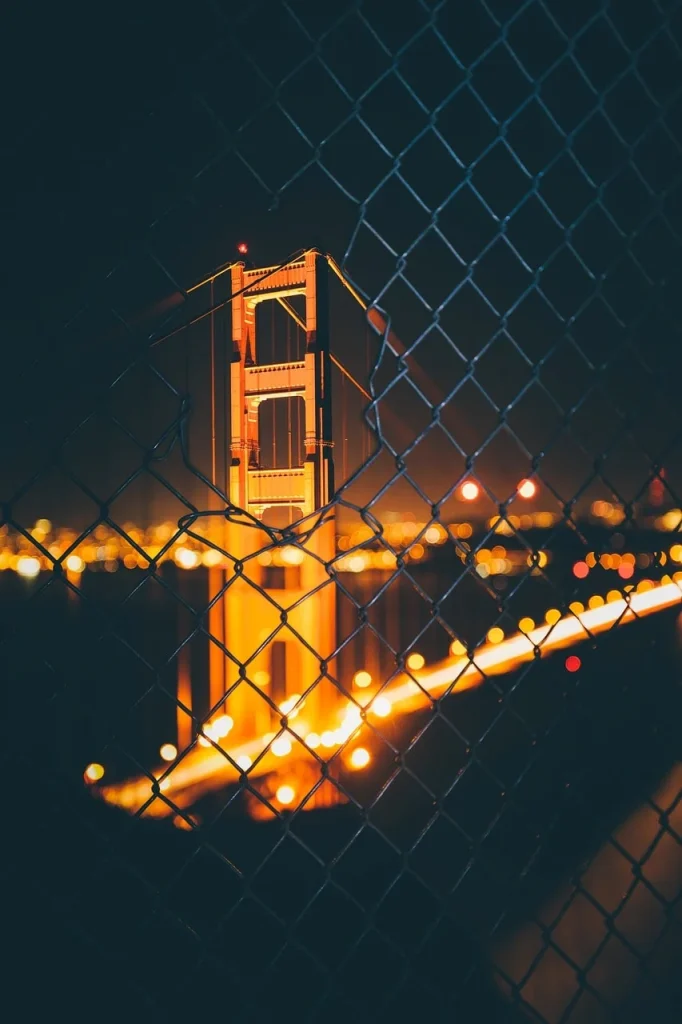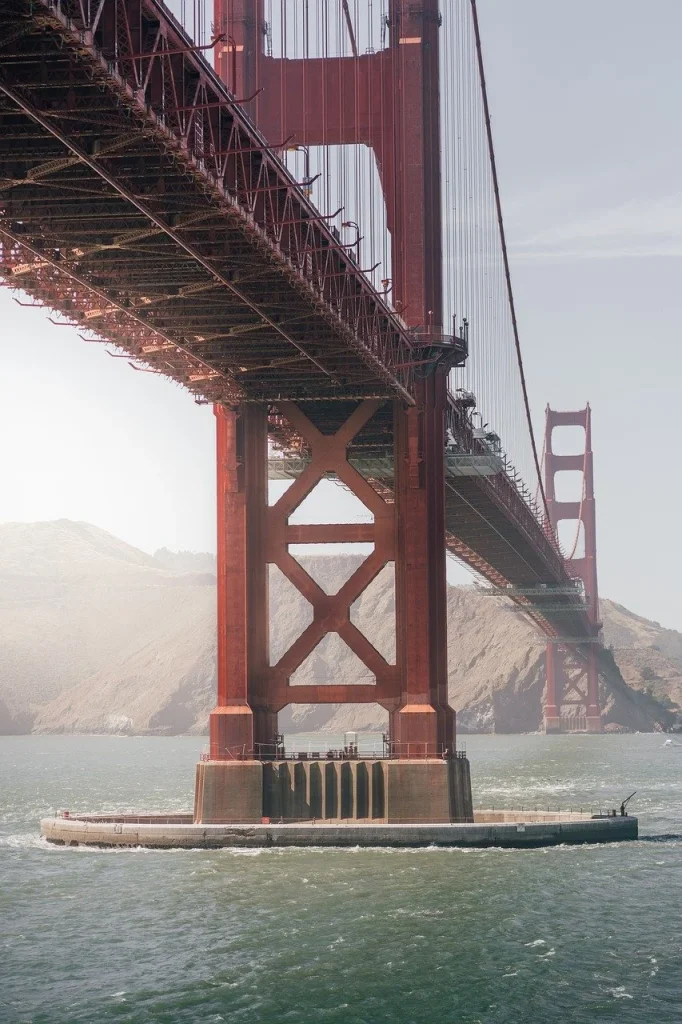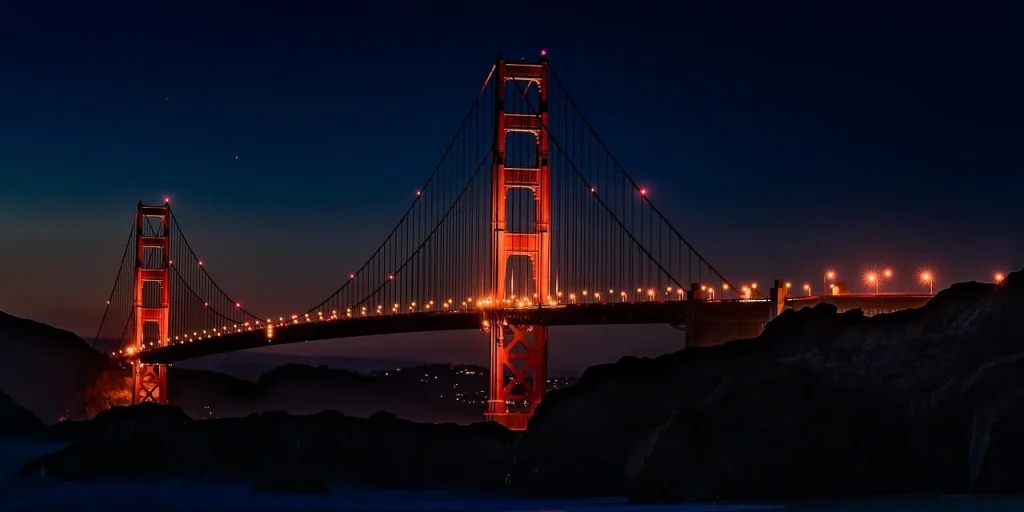As you gaze at the Golden Gate Bridge, do you ever think about the stories it could tell? Since its completion in 1937, this bridge has stood as a testament to human ingenuity and resilience.
In this article, we’ll uncover some interesting facts about the Golden Gate Bridge. We’ll look at everything, from its design and construction to the lesser-known anecdotes that make it so special. Join us as we explore the fascinating details of this American icon.
The Golden Gate Bridge is a giant moving math problem.
Donald MacDonald
Golden Gate Bridge Facts
Get ready to explore the rich history and impressive engineering of the Golden Gate Bridge. Keep your eyes peeled for key facts, as there’s a quiz at the end to prove your knowledge.
- Upon its completion in 1937, it was the tallest and longest suspension bridge in the world.
- The original design was deemed too plain and unattractive, leading to the inclusion of Art Deco elements.
- More than 600,000 rivets hold the tower structures together.
- The bridge’s color, known as International Orange, was chosen to enhance visibility in fog and provide aesthetic appeal.
- Despite the common myth, the bridge is not painted end-to-end each year; maintenance involves touch-ups and sectional repainting.
- The total weight of the bridge exceeds 887,000 tons.
- It has been closed several times due to high winds exceeding 70 miles per hour.
- The bridge’s construction was one of the first projects of its kind to implement a safety net, saving the lives of 19 men.
- Approximately $35 million was the cost of construction during the Great Depression, funded by a major bond measure.
- Aircraft carrier ships must pass beneath the bridge to enter or exit San Francisco Bay.
- Each tower contains 600,000 bolts and stands 746 feet above the water.
- The cables hold a combined length of over 80,000 miles of wire, enough to circle the Earth three times.
- It was declared one of the modern wonders of the world by the American Society of Civil Engineers.

- The bridge’s footpaths are open to pedestrians and bicyclists during daylight hours.
- A unique aspect is its ability to flex in the wind; the bridge can sway up to 27 feet side-to-side.
- The towers were the tallest structures in San Francisco until the completion of the Transamerica Pyramid in 1972.
- Over 10 million people walk across the bridge annually.
- It took more than four years to complete, from 1933 to 1937.
- The bridge’s main span was the longest among suspension bridges until 1964.
- It stands as a major tourist attraction, drawing millions from around the world each year.
- Aerodynamic modifications were made in 1987 to reduce the swaying and twisting observed during high winds.
- The lighting system was upgraded in 1986 to use sodium vapor lamps, enhancing nighttime visibility while saving energy.
- The construction project was completed ahead of schedule and $1.3 million under budget.
- The bridge has a dedicated 24-hour security team to monitor for safety and security issues.
- It survived the 1989 Loma Prieta earthquake with only minor damage.
- An estimated 120,000 automobiles cross the bridge daily.
- Historically, the bridge toll was only $0.50 when it first opened, payable in both directions.
- The bridge is continuously being retrofitted to improve earthquake resilience, a project that has been ongoing since the 1990s.

- The original proposal was contested by the military, fearing that it would allow easier access for enemies to enter the bay.
- The bridge has been featured in numerous films and cultural works, symbolizing San Francisco worldwide.
- Painting the bridge is a continuous task that requires about 38 painters, 5,000 to 10,000 gallons of paint, and 10,000 brushes annually.
- During its construction, the bridge was referred to as “the bridge that couldn’t be built” due to its engineering and financial challenges.
- The bridge is named not for its color, but for the Golden Gate Strait, the entrance to San Francisco Bay from the Pacific Ocean.
- Special regulations govern the airspace around the bridge to protect it from potential threats.
- Average clearance above the high water averages 220 feet, accommodating even the tallest of marine vessels.
- The bridge’s famous color was almost black with yellow stripes, intended for greater visibility for passing ships.
- Each cable, over 36 inches in diameter, was spun from 27,572 strands of wire.
- Extensive studies were conducted to ensure its aerodynamic stability would not lead to the same fate as the Tacoma Narrows Bridge.

- It employs a specially designed wind retrofit system to protect against potential damage from high wind speeds.
- The bridge was originally designed with six lanes of vehicle traffic and has since adapted paths for pedestrian and bicycle use.
- Seismic upgrades included the installation of movement bearings and shear link beams to improve flexibility during earthquakes.
- It was one of the first major projects worldwide to use tower cranes in construction.
- Not just orange; the bridge also features other colors in its components, primarily black on the main cables.
- It holds the distinction of being one of the most photographed bridges in the world due to its iconic design and location.
- The bridge’s walkways were initially open 24 hours before security concerns led to restricted access times.
- A small museum and gift shop on the San Francisco side provides historical insights and memorabilia related to the bridge.
- Wind speeds at the bridge’s deck level have been recorded at over 100 mph during winter storms.
- The U.S. Navy originally proposed painting the bridge with black and yellow stripes to ensure visibility during fog.
- The bridge’s towers were once the tallest on any suspension bridge until surpassed by the Verrazzano-Narrows Bridge in 1964.
- It features a unique Bridge Pavilion, which serves as a welcome center offering historical exhibits and merchandise related to the iconic structure.
Golden Gate Bridge Myths

Now that we’ve explored the facts, let’s tackle the myths. The Golden Gate Bridge is surrounded by stories that often blur the lines between reality and fiction. Let’s separate the truth from the myths.
- The Golden Gate Bridge is Painted End-to-End Annually
It is widely believed that the bridge is painted from end to end each year. However, touch-up painting is carried out constantly to maintain its appearance and protect it from corrosion, but a full repaint is not done annually. - The Bridge’s Color Was an Accident
The color, known as International Orange, was selected intentionally. It was chosen for its visibility in San Francisco’s frequent fog and for its aesthetic appeal, contrasting well with the natural surroundings. - Suicide Barriers Have Always Existed
Despite popular belief, suicide barriers were not part of the original design. They were installed only recently, in 2021, to prevent suicides, reflecting a growing awareness and response to mental health issues. - The Golden Gate Bridge Was the World’s Longest Suspension Bridge at Opening
At its completion in 1937, it was indeed the world’s longest suspension bridge, a title it held until 1964. This feat was heralded as a major engineering accomplishment of its time. - The Bridge is a Top Target for Terrorist Attacks
While it has often been discussed as a potential target due to its iconic status and economic importance, comprehensive security measures are in place. These efforts are designed to ensure the safety and integrity of the structure.
No products found.
Golden Gate Bridge Quotes

We continue with some of my favorite quotes. Feel free to share yours in the comments so I can add them to the list as well.
It is a bridge built by heroes.
Joseph Strauss
Joseph Strauss, the chief engineer of the Golden Gate Bridge, admired the bravery and dedication of the workers who built this iconic structure under treacherous conditions.
The bridge that couldn’t be built.
San Francisco Chronicle
This phrase from the ‘San Francisco Chronicle‘ encapsulates the initial skepticism and eventual triumph in constructing what was then considered an engineering impossibility.
The Golden Gate Bridge is a testament to innovation and determination.
Erica Jong
Erica Jong, an American author, celebrates the innovative design and the unwavering determination required to construct the iconic bridge.
A necklace of surpassing beauty was placed around the lovely throat of San Francisco yesterday.
Herb Caen
Herb Caen, a celebrated San Francisco journalist, vividly described the elegance and beauty of the Golden Gate Bridge as it graced the city’s landscape.
The Golden Gate Bridge looks like a tall, slender young girl in a bridal veil.
Fiorello La Guardia
Fiorello La Guardia, the famed New York City mayor, poetically likened the bridge’s grace and delicate appearance to a young bride, emphasizing its aesthetic elegance.
Golden Gate Bridge FAQ

As we approach the quiz, let’s dive into the FAQs. Read these carefully to test your knowledge and ensure you’re fully prepared!
- What does the Golden Gate Bridge connect?
It spans the Golden Gate, the strait connecting San Francisco Bay to the Pacific Ocean, linking the city of San Francisco to Marin County. - Why is the Golden Gate Bridge famous?
It is renowned for its iconic Art Deco design, striking International Orange color, and status as an engineering marvel, making it one of the most recognizable and photographed bridges in the world. - Can you walk the Golden Gate Bridge?
Yes, pedestrians can walk across it using the east sidewalk during daylight hours, offering stunning views of the bay and the city. - How long did it take to build the Golden Gate Bridge?
Construction of the Golden Gate Bridge took just over four years, starting in January 1933 and opening to the public in May 1937. - Is the Golden Gate Bridge earthquake-proof?
Originally not designed to modern seismic standards, the bridge has undergone several upgrades to improve its earthquake resilience, though complete retrofitting is ongoing to ensure it can withstand significant earthquakes.
No products found.
Golden Gate Bridge Trivia

Welcome to our Golden Gate Bridge quiz! Get ready to bridge your knowledge gaps, or we might just have to suspend you over San Francisco Bay!
Conclusion
To sum up, the Golden Gate Bridge isn’t just a bridge; it’s a masterpiece of art and engineering. It captures the heart of San Francisco and offers a gateway to endless possibilities.
Every cable and bolt tells a story of endurance and resilience. Till next time, stay curious and explore more. Cheers.
5 Sources Used For This ArticleGolden Gate Bridge – Fandom
Interesting Golden Gate Bridge – Learnodo Newtonic
What was different about the Golden Gate Bridge? – Study Country
History of the Golden Gate Bridge – Blogs Csun


